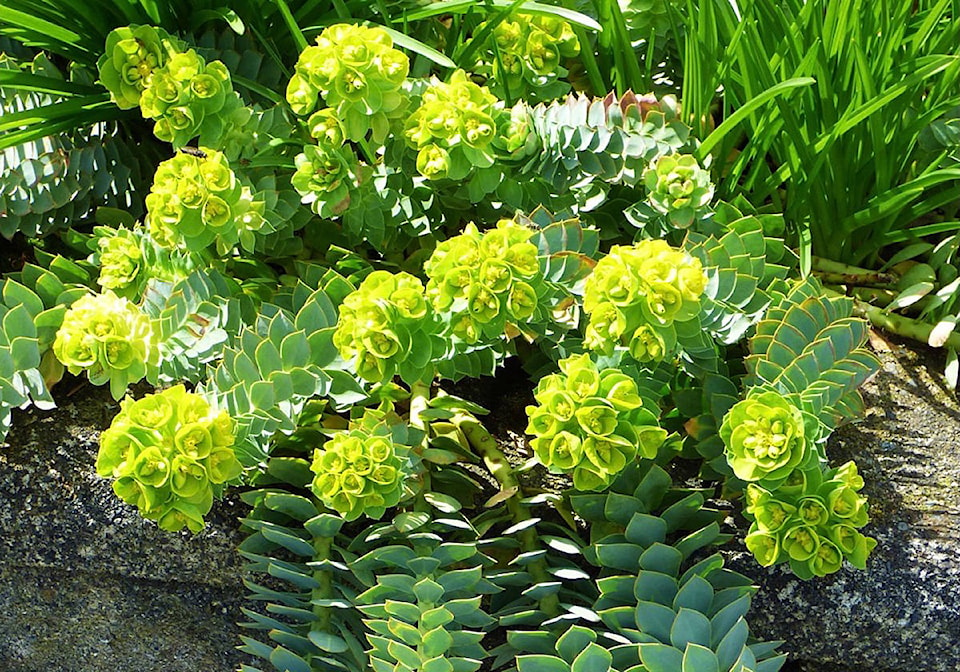Now is the best time to explore the world of trailing perennials to cover those bare retaining walls or steep slopes.
Most of these are spring blooming, so a walk in your neighborhood this time of year will provide myriad plant choices and you actually get to see their true flower colours and growth habits.
The other benefit to making your decision now is that most garden centres are well stocked with these plants, while later in the season some of them can be hard to find.
So let’s start with the old-fashioned favourites, such as wall cress, perennial alyssum and rock cress.
Wall cress typically comes in two flower colours, pure white and bright pink, but there is a nicely variegated form which takes on purplish overtones in the colder weather.
Those bright gold flowers you notice are the perennial alyssum, either Aurinia or Alyssum montanum, both of which will need a little pruning after blooming to keep them tidy.
Last but not least of the garden stalwarts is rock cress, which comes in a dizzying array of colours, including red, violet, purple and many variegated leaf forms. These too will need a quick pruning after flowering in order to keep the foliage looking fresh.
For those of you hoping for colour during the summer, I suggest Lithodora ‘Grace Ward’, an evergreen perennial with bright gentian-blue flowers that blooms from May to August. It requires near perfect drainage and acidic soils (which is usually not a problem here) to thrive, so if you have a newly poured concrete retaining wall, you may want to delay planting this species until the lime has dissipated.
Another good evergreen option is the exotic looking donkey-tail spurge, with its dangling limbs of whorled blue-green foliage and terminal yellow flowers. The only caution I would give with this plant is to wear gloves when pruning it, as the sap from this species can burn your skin.
There are many trailing bellflowers to choose from, but the ones I tend to use the most include the repeat-blooming ‘Blue Waterfall’, the deep purplish-blue ‘Birch Hybrid’ and ‘Dickson’s Gold’, which features bright chartreuse foliage contrasted by lavender-blue flowers.
Creeping phlox is another floriferous alpine with a vast array of colours and an extremely low profile, growing only five to 15 centimetres high. These are drought tolerant once established with some of the better cultivars being ‘Emerald Blue’, ‘Candy Stripe’, ‘Fort Hill’ and ‘Emerald Pink’. These need regular division every three years and should be pruned back after flowering to promote fresh growth, as the leaves are evergreen.
Low growing sedums are another drought tolerant choice and come in a myriad of foliage options including gold, grey, red, green and purple-tinted. These can be a bit precocious, so give them lots of space to grow so they don’t crowd out adjacent plants. That said, they are extremely drought tolerant and provide summer blooms of yellow, pink, pale orange or rose.
Some of the better species or cultivars include ‘Cape Blanco’, Sedum acre ‘Aureum’, ‘Dragon’s Blood’, ‘Angelina’ and the native Oregon stonecrop.
Pinks are another traditional wall garden perennial, although these don’t trail as heavily as the aforementioned plants.
A few of my favourites over the years have been ‘Firewitch’, ‘Frosty Fire’, ‘Vampire’ and ‘Tiny Rubies’, with their miniature rose-pink double carnation blooms.
Mike Lascelle is a local nursery manager and gardening author (hebe_acer@hotmail.com).
